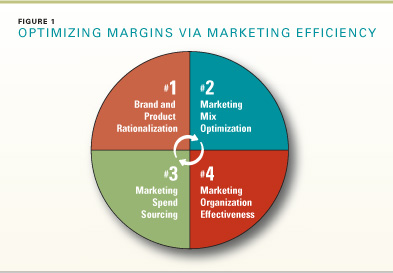Do More with Less: Philippe Lebard, Deloitte Consulting
In today's tough economic environment, consumer product (CP) companies are increasingly looking for operating efficiencies to offset shrinking margins. Now more than ever, the chief marketing officer (CMO) is expected to do more with less.
CMOs are facing relentless and constant pushback from their CEO/CFO about the justification of their investment. There is also intense pressure to "decrease your budget by 30 percent" and a personal desire to make sure that programs increase sales and margins. Structural cost cutting yields large marketing efficiency without sacrificing effectiveness, because it:
- Captures deeper cost reductions, faster and addresses total marketing spend
- Targets four complementary opportunity areas to deliver significant gains in efficiency (see Figure 1)

Opportunity No. 1: Cull laggard brands and products
Most CP companies have brands and products that no longer warrant the cost of their upkeep. Brand rationalization begins with a brutal analysis of the profitability and equity of each brand; a market segmentation identifying brand duplications; a brand transfer analysis showing how consumers would switch if their brand were eliminated; and a comparative analysis of price elasticity. Success lies in a careful implementation laying out exactly how the laggard brands will be eliminated without volume loss.
Opportunity No. 2: Align spend with most attractive market opportunities and effective media
Deloitte's experience suggests that 15 percent to 55 percent of marketing spend is unproductive. Our approach identifies spend on mediocre categories, markets, channels and customers for re-investment, thereby assisting leading marketers to reach their target of 10 percent to 40 percent more economically through targeted media. For many segments, that media is a fluid digital ecosystem of peer-to-peer networks and other "unstructured" influencers. Creating an effective and efficient marketing mix begins with these "zero-based" questions:
- What media do our targets consume? Which critical touch points should we leverage?
- Which marketing programs generate the highest returns?
- What are the most effective emerging media?
Finally, cost cutting can double as green marketing, shifting from print to digital communications.
Opportunity No. 3: Renegotiate everything
Too often, marketing executives hire an agency then never ask for proof of performance, assuming the "experts" make optimal choices every day. To avoid this: leverage enterprise purchasing power and benchmarks to reach optimum pricing; align agency compensation with performance; build discount entitlement into contracts; standardize purchasing; and audit contract fulfillment periodically.
Opportunity No. 4: Focus your marketing team strategically
A fresh look at the marketing organization should include headcount and administrative costs. Substantial cuts come from consolidating roles, reducing organizational layers, eliminating duplications and positions far removed from customers. Our analysis starts by answering these questions:
- Which roles, when combined, would have more market impact?
- Are some roles mismatched with day-to-day contributions?
- Which positions could be eliminated with little effect on demand generation?
- How might technology help use resources better?
Simplifying, optimizing and automating marketing processes and systems (program planning, brand budgeting, invoice tracking) improves efficiency without hurting effectiveness. Legacy systems are often grafted onto newer ones, leading to waste when updating the same information in different systems.
When it comes to cost cutting, bold is better. For decisive CMOs, the downturn could be a radically productive time: tough decisions made today could net huge dividends tomorrow. Structural cost cutting is a productive way to find meaningful efficiencies without jeopardizing brand equity or profit and to redirect resources from ineffective to growth-generating programs. The only rule: Act now, boldly and decisively.
